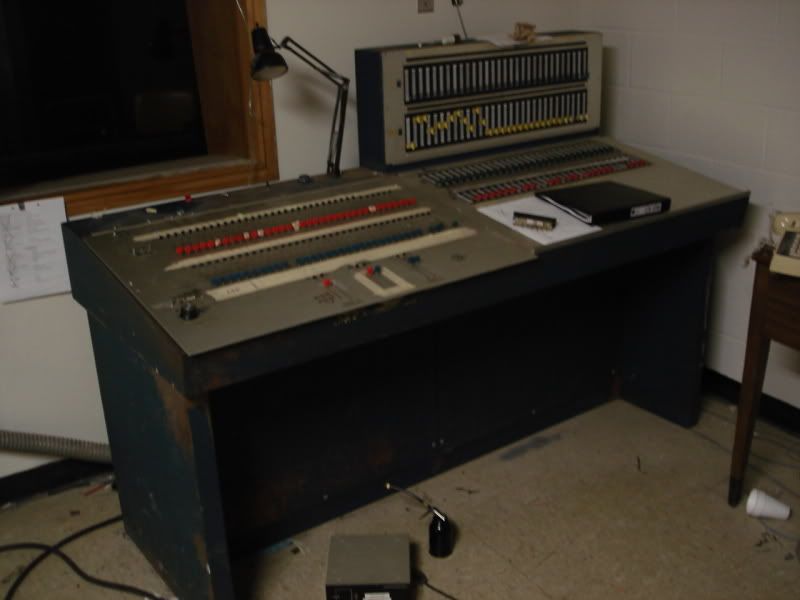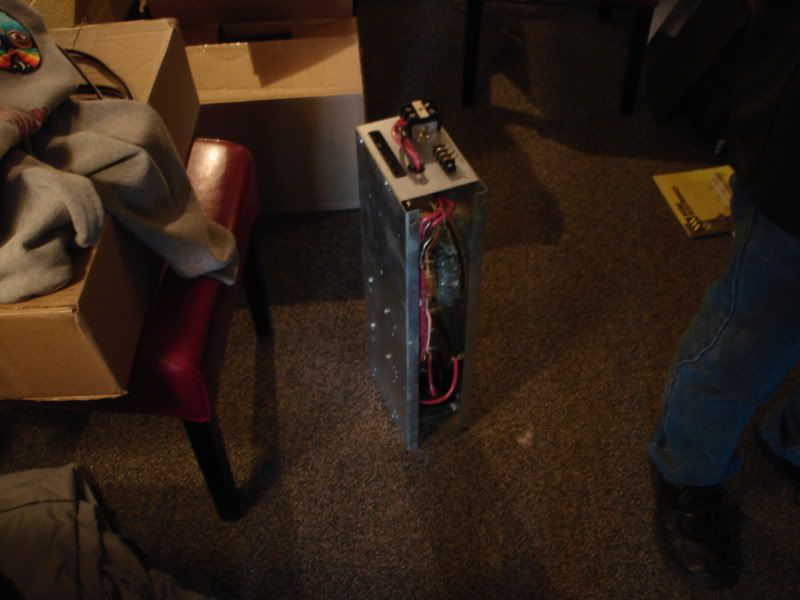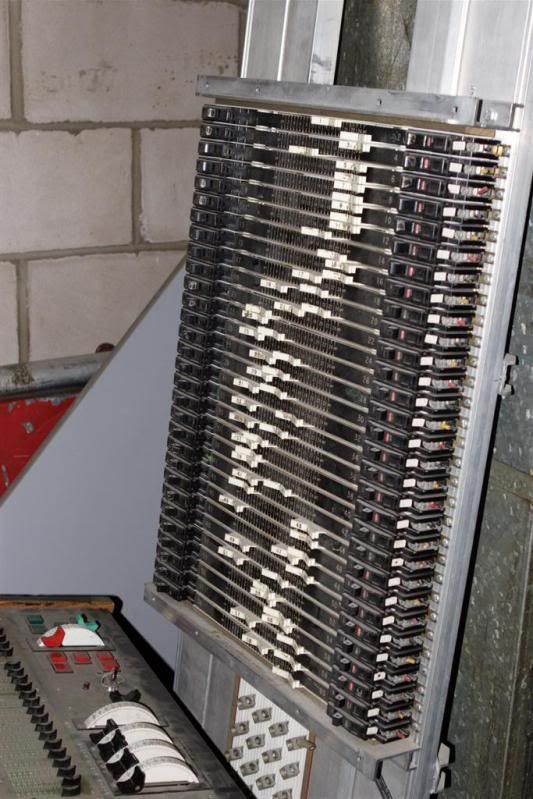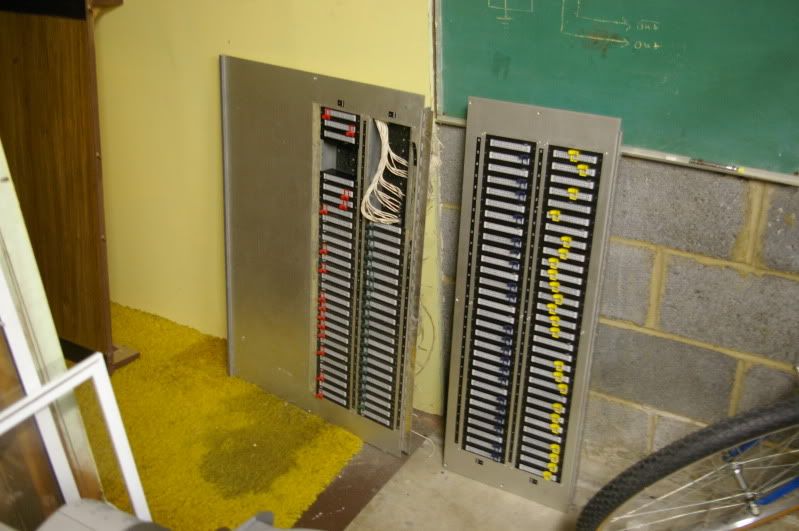Ready for a picture of this board?

It was a fun board. Kinda. As pretty much the only lighting designer and one of the few who knew a bit about electronics, the board was kind of my baby. For the two years that I had to operate this board I had to somehow keep it going. It was a challenge. I'll get onto the dimmers themselves in a minute, but the board had some interesting quirks itself.
First, even though the control panel had been replaced, the replacement wasn't in tip shape anymore. It was an X/Y preset board, but only the X preset worked. The Y preset contained many channel faders that no longer worked and if you brought the submaster fader for the Y preset all the way down, the carbon element inside would start to glow. It was much fun switching lighting patterns between scenes, although luckily the dimmers had a lot of power and we were able to keep to only a few of them. What was very interesting about this board was that it got its power from the dimmer itself. The only way to fully turn off the console was to throw a 300 amp breaker in the basement of the facility. Therefore, when working inside the board, there were two open-frame relays that were always hot (that is, the practice was to just hit the console power, which just cut supply to the faders and other control circuitry. Almost all the power supplies in the console remained burning). Long story short, the board was Supposed to have screws to hold the panels down, but they were either lost or never put back in due to the number of times it needed to be opened for maintenance.
At one point, because it was a hazard, I removed the circuitry for the Y Preset submaster. Upon telling the Director of Engineering, I was told that that was not good and that it should be put back so the safety of the board could be demonstrated (we were trying to get a new board). I reluctantly agreed, and after about 15 minutes of time, I had all the cut wires put back. As a check, I flicked the board on and brought up some lights. I then absent mindedly leaned on the top of the board to look at the lights, and they went out. I eased off and they came back on again. Naturally, I lifted the console back up to take a look at what I had done wrong.
Now, I must do a slight aside. If you look closely in the picture of the console, you will notice that the replacement board (the one on the left) is slightly longer than the desk can accommodate. As a matter of fact, The submasters and masters would have sat right on the rim of the desk if modifications were not made to it. And so, three notches were made in the rim of the desk to accommodate them. This essentially left two wide spikes sitting between the faders.
Now, the panel was quite heavy. To lift it you needed significant force and naturally one assumes that after many times of opening the board and nothing going wrong, something such as a wire getting caught on something will not happen. But that would be normal. A wire connecting the X preset master to the crossfader snagged one of those spikes and ripped the X preset master in two. That was essentially our grand master. After numerous attempts to get another fader that would work, and somehow wire it properly, we gave up and had to just hardwire it. From then on the board was operated with a long bar of metal, wide enough to bring up all the channel faders at once, and then bring 'em all back down again. We did a play like this.
Now on to dimmers. The dimmers themselves were interesting. The modules were essentially a control card, an SCR on a live heatsink and a choke coil wrapped in a steel box, open on the top and bottom. Here's one sitting in an office after being removed:

There were thirty of these, plus ones for the house lights placed into a large blue steel cabinet with a circuit breaker box on one side of it to cut power to individual dimmers. The house lights could be controlled from a number of different remote places, and this cabinet also contained the circuitry(relays!) for that function. What I loved about it was the way in which the dimmers were suspended in the cabinets. Essentially, there was a horizontal metal rod in the front of the cabinet and one in the back that the dimmer would teeter on. A little piece of metal at the front would hold the dimmer to the front bar with a small screw. There was no way of removing a dimmer without having it crash onto the dimmer below it first, which is great when you want to remove one live. Especially with those exposed live heatsinks on the SCRs.
The best part of the whole system was that after trying all of them, we realized that only about 10 of the dimmers actually worked properly. By the time it was retired, only about 5 of them worked. Luckily, they were all about 6KW dimmers, so sometimes an entire scene could be placed on one dimmer.
The last interesting part about the original system was what I call the "high voltage patch." I have seen many of these in pictures. Many of them employ a "plugboard" approach; looking like an old fashioned telephone switchboard. However, Stage-Brite made something very interesting. Essentially, it was a matrix switch. Any one of the ~90 lighting outlets could be patched to one of the 30 dimmers with the positioning of a slider.

The picture here isn't very much good in giving a descriptive look at how the system operates, but the lighting wasn't very good on stage right where this thing lived. However, a picture from a Canadian museum I found recently shows one outside of its casing:

This picture was posted on its side on that website. Must've thought it was a console...
Circuit breakers on both sides cut off power to the individual outlets to allow for patching. Selections were made by slightly pulling out the little sliders and moving them sideways into position for the proper dimmer. When I saw it open on demolition day I thought it was one of the most clever things. Before I knew any better, the first time I saw it I did in fact think that it was the lighting controller. You can still find the patent for it out there, I believe US#4,041,257.
Our panel in particular was fun, for nothing could be patched to outlet number four. If something was, either a buzzing noise or an ember would be drawn out of it. Never did figure out what was on that circuit (it was up in the proscenium).
towards the end, the board was replaced further. Another facility with a similar, as a matter of fact, duplicate, system gave us a DMX512 to analog controller. In the process of installing it, we lost some of the dimmers because some were not into dealing with the change from -24vdc to +12vdc control voltage. After this I believe we had 7 left that we were able to control with an ETC X/Y board.
The facility that gave us the converter had all of its dimmers functioning properly. It even had the original half of our type of console. It was the only time I got to see something like it in person, not in a drawing. It was being removed, but in retrospect I can't seem to understand why we didn't replace our dimmers with their functional ones(they were offered). Or even try to get the board back operational with their console. Between all the plug-in fader modules we would've had we could have probably completely restored it. Such is life.
The most creative thing I did with that setup was during a music revue that we put on every year. The ETC board was laid over the dead parts of the Stage-Brite console. The SB console only could operate house lights and non-dim channels at this point. The band performing was up on a platform which had diffusion put in the front of it and an array of red, blue and green lamps placed behind it. Patching the lights into the floor outlets and then the non-dim channels, I was able to flick the lights on and off in sequence, or however using the remaining non-dim toggle switches. Not too sophisticated, but not bad for a (at this point) 5 channel lighting board.
Eventually the system was removed from the facility and I got to keep a few pieces of the board. All of the original preset panels are stowed in my basement:

I also have the little lamp that was part of the board and can be seen above, and the Simpson meter from the test circuit of the high voltage patch.
The plug-in faders are very nice and quite well made. I spent a good time restoring all of them, the smaller panel right now as a display piece, the larger panel perhaps to someday be used again for something. A few pictures of the restored faders:


The faders are lit with a small bulb operating on 24vac. The sliders are really nice, especially now that they have been cleaned and lubricated. Sadly none of the other system was salvaged, and the components I have are the only ones left of either system. All I guess I can say at this point now is that it wouldn't have been a bad console if it were cared for a little better. However, despite that it sure gave us some fun things to talk about today.

No comments:
Post a Comment